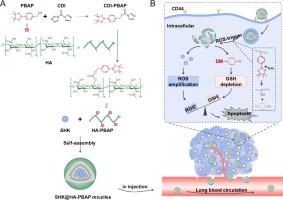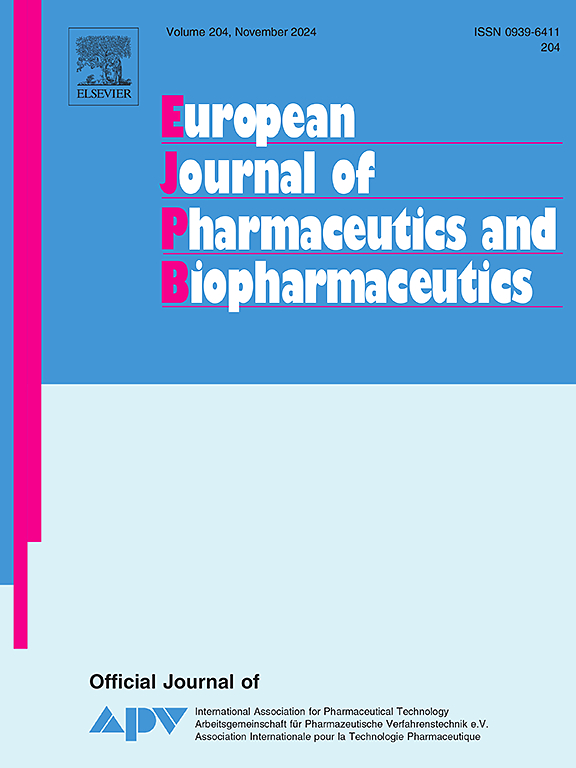简单的 ROS 响应胶束负载 Shikonin,通过破坏细胞内氧化还原平衡实现高效的卵巢癌靶向治疗。
IF 4.4
2区 医学
Q1 PHARMACOLOGY & PHARMACY
European Journal of Pharmaceutics and Biopharmaceutics
Pub Date : 2024-10-05
DOI:10.1016/j.ejpb.2024.114525
引用次数: 0
摘要
卵巢癌是女性最常见的恶性肿瘤。石杉碱甲是一种中药提取物,可通过诱导活性氧(ROS)治疗卵巢癌。然而,其临床应用受到肿瘤靶向性差和生物利用度低的限制,而且肿瘤细胞内谷胱甘肽(GSH)等抗氧化剂水平的升高进一步削弱了其治疗潜力。本研究利用透明质酸-苯硼酸频哪醇酯共轭(HA-PBAP)技术开发了一种负载有 SHK 的 ROS 响应胶束新配方,通过破坏细胞内的氧化还原平衡对卵巢癌进行靶向治疗。SHK@HA-PBAP通过HA和CD44受体之间的相互作用对卵巢癌细胞进行靶向递送。癌细胞内化后,高水平的细胞内氧化还原反应会引发 SHK@HA-PBAP 的降解,同时释放 SHK 并生成 GSH 清除剂醌甲醚(QM)。SHK@HA-PBAP 释放的 SHK 和 QM 能有效诱导 ROS 的产生并消耗细胞内的 GSH,从而破坏细胞内的氧化还原平衡,进而诱导细胞死亡。这些特性共同抑制了卵巢癌的生长。体外和体内研究表明,与游离 SHK 相比,SHK@HA-PBAP 胶束在 A2780 细胞和 A2780 肿瘤小鼠中均表现出卓越的抗肿瘤功效。ROS反应型SHK@HA-PBA为卵巢癌的治疗提供了一种前景广阔的治疗方法。本文章由计算机程序翻译,如有差异,请以英文原文为准。

Simple ROS-responsive micelles loaded Shikonin for efficient ovarian cancer targeting therapy by disrupting intracellular redox homeostasis
Ovarian cancer is the most common malignant tumor in women. Shikonin (SHK), an herbal extract from Chinese medicine, shows promise in treating ovarian cancer by inducing reactive oxygen species (ROS). However, its clinical use is limited by poor tumor targeting and low bioavailability, and its therapeutic potential is further compromised by the elevated levels of antioxidants such as glutathione (GSH) within tumor cells. In this study, a novel formulation of ROS-responsive micelles loaded with SHK was developed using hyaluronic acid-phenylboronic acid pinacol ester conjugation (HA-PBAP) for targeted therapy of ovarian cancer through disruption of intracellular redox homeostasis. The SHK@HA-PBAP exhibits targeted delivery to ovarian cancer cells through the interaction between HA and CD44 receptors. Upon internalization by cancer cells, the high levels of intracellular ROS triggered the degradation of SHK@HA-PBAP and simultaneously released SHK and generated GSH scavenger quinone methide (QM). The SHK and QM released from the SHK@HA-PBAP effectively induce the production of ROS and deplete intracellular GSH, leading to the disruption of intracellular redox homeostasis and subsequent induction of cell death. These characteristics collectively inhibit the growth of ovarian cancer. In vitro and in vivo studies have demonstrated that SHK@HA-PBAP micelles exhibit superior antitumor efficacy compared to free SHK in both A2780 cells and A2780 tumor-bearing mice. The ROS-responsive SHK@HA-PBA presents a promising therapeutic approach for the treatment of ovarian cancer.
求助全文
通过发布文献求助,成功后即可免费获取论文全文。
去求助
来源期刊
CiteScore
8.80
自引率
4.10%
发文量
211
审稿时长
36 days
期刊介绍:
The European Journal of Pharmaceutics and Biopharmaceutics provides a medium for the publication of novel, innovative and hypothesis-driven research from the areas of Pharmaceutics and Biopharmaceutics.
Topics covered include for example:
Design and development of drug delivery systems for pharmaceuticals and biopharmaceuticals (small molecules, proteins, nucleic acids)
Aspects of manufacturing process design
Biomedical aspects of drug product design
Strategies and formulations for controlled drug transport across biological barriers
Physicochemical aspects of drug product development
Novel excipients for drug product design
Drug delivery and controlled release systems for systemic and local applications
Nanomaterials for therapeutic and diagnostic purposes
Advanced therapy medicinal products
Medical devices supporting a distinct pharmacological effect.

 求助内容:
求助内容: 应助结果提醒方式:
应助结果提醒方式:


